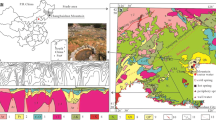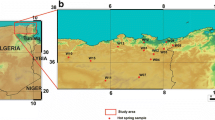Abstract
A systematic geochemical surveillance on the fumaroles of Solfatara and the boiling pools of Pisciarelli was carried out by discontinuous monitoring of the chemical composition of the emitted fluids during the Phlegraean Fields bradyseismic crisis which has begun in 1982. The fluids are considered to be produced by the ebullition of shallow aquifers receiving a convective gaseous inflow from the underlying magma chamber.
Increased water vapor concentrations at a constant temperature of about 155 °C throughout the investigated period, along with the occurrence of ground deformations and seismic phenomena, are interpreted as resulting from an increased heat supply to the boiling water bodies.
Dissolution processes and reactions with the confining rocks can alter the chemical composition of fluids escaping from magma to a large extent. Therefore it does not appear correct to consider the absolute values of any chemical constituent for geochemical surveillance without taking this modifying factor into account. Acid gases will be preferably absorbed by the above mentioned aquifers, while other species like H2, N2, O2, CH4, will instead increase their relative concentrations. Because of this, water vapour concentrations and the ratios H2S/CO2 and H2/CH4 in surface thermal manifestations appear to reflect better the varying extent of the observed phenomenon.
On the basis of these parameters, and of both the upheaval rate and the intensity of seismic events, maximum values in the convective input of magmatic origin are estimated to have occurred at the beginning of the crisis and in September–October 1983.
As long as water bodies at shallow depth are able to buffer the convective flow both thermally and chemically, no important volcanic activity can develop. When the absorbing capacity of these aquifers is exhausted, the increasing temperature and the changing characteristics of fluids towards a magmatic composition will indicate a higher probability of eruptive phenomena.
Similar content being viewed by others
References
Corrado, G., Guerra, I., Lo Bascio, A., Luongo, G. andRampoldi, R., 1977,Inflation and Microearthquake Activity of Phlegraean Fields, Italy. Bull. Volcanol.,40–3.
Dall'Aglio, M., Martini, M., Tonani, F., 1972, Rilevamento geochimico delle emanazioni vulcaniche dei Campi Flegrei. Quaderni Ricerca Scientifica,83, p. 152–181.
Gerlach, T.M., 1982,Interpretation of the Merapi Field Gas Chromatograph Data. Bull. Volcanol.,45, p. 249–252.
Giggenbach, W., 1982,The Chemical and Isotopic Composition of Gas Discharges from New Zeland Andesitic Volcanoes. Bull. Volcanol.,45, p. 253–256.
Graeber, E.J., Modreski, P.J., Gerlach, T.M., 1979,Compositions of Gases collected during the 1977 East Rift Eruption, Kilauea, Hawaii. Jour. Volc. Geoth. Res.,5, p. 337–344.
Kirsanov, I.T., 1966,Acid Volcanism and Thermal Manifestations in the Area of Mutnovsky and Gorely Volcanoes (Southern Kamchatka). Bull. Volcanol.,30, p. 139–151.
Le Guern, F., Carbonnelle, J., Tazieff H., 1979,Erta 'Ale Lava Lake: Heat and Gas Transfer to the Atmosphere. Jour. Volc. Geoth. Res.,6, p. 27–48.
Martini, M., Cellini Legittimo, P., 1982,Acid and Condensable Constituents in Fumarolic Gases of Usu (Japan) and Mount St. Helens (USA). Rend. Soc. It. Min. Petr.,38, p. 771–773.
--, --,Piccardi, G., Glannini, L., 1983,Low Temperature Manifestations in Volcanic Areas. Rend. Soc. It. Min. Petr.,39 (in press).
Matsuo, S., Ossaka, J., Hirabayashi, J., Ozawa, T., Kimishima, K., 1982,Chemical Nature of Volcanic Gases of the Usu Volcano in Japan. Bull. Volcanol.,45, p. 261–264.
Menyailov, I.A., Nikitina, L.P., 1980,Chemistry and Metal Contents of Magmatic Gases: the New Tolbachik Volcanoes Case (Kamchatka). Bull. Volcanol.,43, p. 197–205.
Piccardi, G., 1982,Fumarole Gas Collection and Analysis. Bull. Volcanol.,45, p. 257–260.
--,Cellini Legittimo, P., 1983,A Sampling and Chemical Analysis Procedure of Fumarolic Gases. Mikrochimica Acta (in press).
Tonani, F., 1970,Geochemical Methods of Exploration for Geothermal Energy. U.N. Symposium on the Development and Utilization of Geothermal Resources, Pisa, p. 492–515.
Author information
Authors and Affiliations
Additional information
CNR —Centro di studio per la mineralogia e la geochimica dei sedimenti.
Rights and permissions
About this article
Cite this article
Martini, M., Legittimo, P.C., Piccardi, G. et al. Composition of hydrothermal fluids during the bradyseismic crisis which commenced at Phlegraean Fields in 1982. Bull Volcanol 47, 267–273 (1984). https://doi.org/10.1007/BF01961557
Received:
Revised:
Issue Date:
DOI: https://doi.org/10.1007/BF01961557




